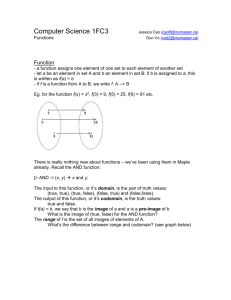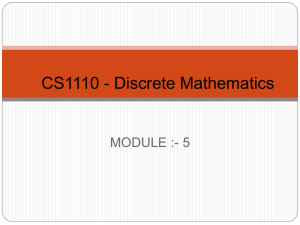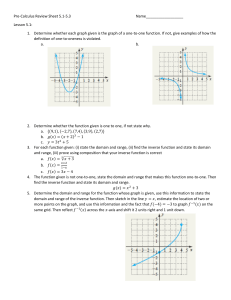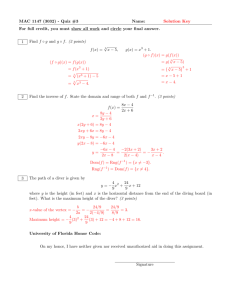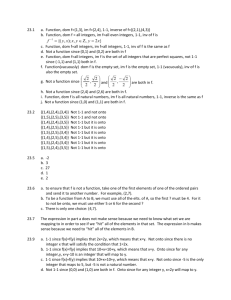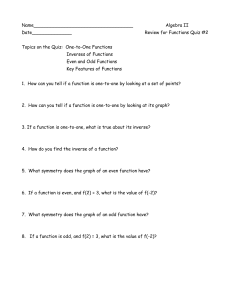Functions
advertisement
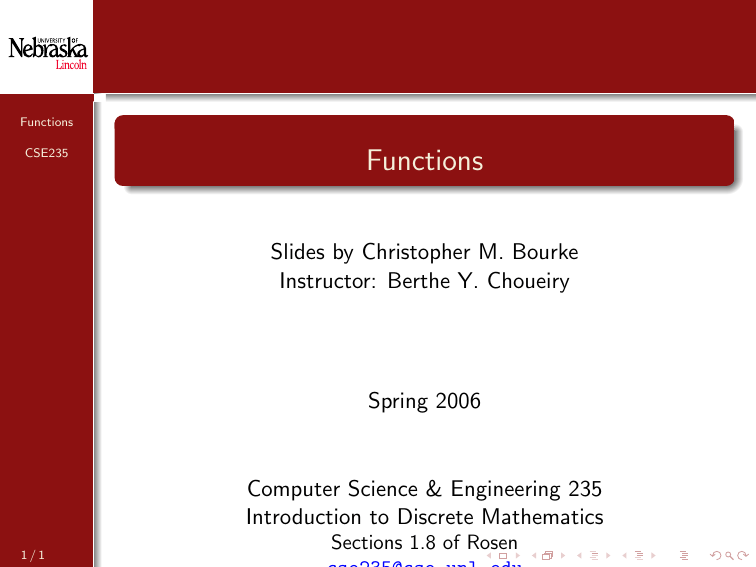
Functions
CSE235
Functions
Slides by Christopher M. Bourke
Instructor: Berthe Y. Choueiry
Spring 2006
Computer Science & Engineering 235
Introduction to Discrete Mathematics
1/1
Sections 1.8 of Rosen
Introduction
Functions
CSE235
You’ve already encountered functions throughout your
education.
f (x, y) = x + y
f (x)
= x
f (x)
= sin x
Here, however, we will study functions on discrete domains and
ranges. Moreover, we generalize functions to mappings. Thus,
there may not always be a “nice” way of writing functions like
above.
2/1
Definition
Function
Functions
CSE235
Definition
A function f from a set A to a set B is an assignment of
exactly one element of B to each element of A. We write
f (a) = b if b is the unique element of B assigned by the
function f to the element a ∈ A. If f is a function from A to
B, we write
f :A→B
This can be read as “f maps A to B”.
Note the subtlety:
Each and every element in A has a single mapping.
Each element in B may be mapped to by several elements
in A or not at all.
3/1
Definitions
Terminology
Functions
CSE235
Definition
Let f : A → B and let f (a) = b. Then we use the following
terminology:
A is the domain of f , denoted dom(f ).
B is the codomain of f .
b is the image of a.
a is the preimage of b.
The range of f is the set of all images of elements of A,
denoted rng(f ).
4/1
Definitions
Visualization
Functions
CSE235
f
a
b
A
B
A function, f : A → B.
5/1
Definitions
Visualization
Functions
CSE235
f
a
b
A
B
Domain
A function, f : A → B.
6/1
Definitions
Visualization
Functions
CSE235
f
a
b
A
B
Domain
Codomain
A function, f : A → B.
7/1
Definitions
Visualization
Functions
CSE235
Preimage
f
a
b
A
B
Domain
Codomain
A function, f : A → B.
8/1
Definitions
Visualization
Functions
CSE235
Image, f (a) = b
Preimage
f
a
b
A
B
Domain
Codomain
A function, f : A → B.
9/1
Definitions
Visualization
Functions
CSE235
Preimage
Range
Image, f (a) = b
f
a
b
A
B
Domain
Codomain
A function, f : A → B.
10 / 1
Definition I
More Definitions
Functions
CSE235
Definition
Let f1 and f2 be functions from a set A to R. Then f1 + f2
and f1 f2 are also functions from A to R defined by
(f1 + f2 )(x) = f1 (x) + f2 (x)
(f1 f2 )(x)
= f1 (x)f2 (x)
Example
Let f1 (x) = x4 + 2x2 + 1 and f2 (x) = 2 − x2 then
(f1 + f2 )(x) =
=
(f1 f2 )(x)
=
=
11 / 1
(x4 + 2x2 + 1) + (2 − x2 )
x4 + x2 + 3
(x4 + 2x2 + 1) · (2 − x2 )
−x6 + 3x2 + 2
Definition II
More Definitions
Functions
CSE235
Definition
Let f : A → B and let S ⊆ A. The image of S is the subset of
B that consists of all the images of the elements of S. We
denote the image of S by f (S), so that
f (S) = {f (s) | s ∈ S}
Note that here, an image is a set rather than an element.
12 / 1
Definition III
More Definitions
Functions
CSE235
Example
Let
A = {a1 , a2 , a3 , a4 , a5 }
B = {b1 , b2 , b3 , b4 }
f = {(a1 , b2 ), (a2 , b3 ), (a3 , b3 ), (a4 , b1 ), (a5 , b4 )}
S = {a1 , a3 }
Draw a diagram for f .
The image of S is f (S) = {b2 , b3 }
13 / 1
Definition IV
More Definitions
Functions
CSE235
Definition
A function f whose domain and codomain are subsets of the
set of real numbers is called strictly increasing if f (x) < f (y)
whenever x < y and x and y are in the domain of f . A
function f is called strictly decreasing if f (x) > f (y) whenever
x < y and x and y are in the domain of f .
14 / 1
Injections, Surjections, Bijections I
Definitions
Functions
CSE235
Definition
A function f is said to be one-to-one (or injective) if
f (x) = f (y) ⇒ x = y
for all x and y in the domain of f . A function is an injection if
it is one-to-one.
Intuitively, an injection simply means that each element in A
uniquely maps to an element in b.
It may be useful to think of the contrapositive of this definition:
x 6= y ⇒ f (x) 6= f (y)
15 / 1
Injections, Surjections, Bijections II
Definitions
Functions
CSE235
Definition
A function f : A → B is called onto (or surjective) if for every
element b ∈ B there is an element a ∈ A with f (a) = b. A
function is called a surjection if it is onto.
Again, intuitively, a surjection means that every element in the
codomain is mapped. This implies that the range is the same
as the codomain.
16 / 1
Injections, Surjections, Bijections III
Definitions
Functions
CSE235
Definition
A function f is a one-to-one correspondence (or a bijection, if
it is both one-to-one and onto.
One-to-one correspondences are important because they endow
a function with an inverse. They also allow us to have a
concept of cardinality for infinite sets!
Let’s take a look at a few general examples to get the feel for
these definitions.
17 / 1
Function Examples
A Non-function
Functions
CSE235
A
B
a1
b1
a2
b2
a3
b3
a4
b4
This is not a function: Both a1 and a2 map to more than one
element in B.
18 / 1
Function Examples
A Function; Neither One-To-One Nor Onto
Functions
CSE235
A
B
a1
b1
a2
b2
a3
b3
a4
b4
This function not one-to-one since a1 and a3 both map to b1 .
It is not onto either since b4 is not mapped to by any element
in A.
19 / 1
Function Examples
One-To-One, Not Onto
Functions
CSE235
A
B
a1
b1
a2
b2
a3
b3
b4
This function is one-to-one since every ai ∈ A maps to a
unique element in B. However, it is not onto since b4 is not
mapped to by any element in A.
20 / 1
Function Examples
Onto, Not One-To-One
Functions
CSE235
A
B
a1
b1
a2
b2
a3
b3
a4
This function is onto since every element bi ∈ B is mapped to
by some element in A. However, it is not one-to-one since b3 is
mapped to more than one element in A.
21 / 1
Function Examples
A Bijection
Functions
CSE235
A
B
a1
b1
a2
b2
a3
b3
a4
b4
This function is a bijection because it is both one-to-one and
onto; every element in A maps to a unique element in B and
every element in B is mapped by some element in A.
22 / 1
Exercises I
Exercise I
Functions
CSE235
Example
Let f : Z → Z be defined by
f (x) = 2x − 3
What is the domain and range of f ? Is it onto? One-to-one?
Clearly, dom(f ) = Z. To see what the range is, note that
b ∈ rng(f )
23 / 1
⇐⇒
⇐⇒
⇐⇒
b = 2a − 3
a∈Z
b = 2(a − 2) + 1
b is odd
Exercises II
Exercise I
Functions
CSE235
Therefore, the range is the set of all odd integers. Since the
range and codomain are different, (i.e. rng(f ) 6= Z) we can
also conclude that f is not onto.
However, f is one-to-one. To prove this, note that
f (x1 ) = f (x2 ) ⇒ 2x1 − 3 = 2x2 − 3
⇒ x1 = x2
follows from simple algebra.
24 / 1
Exercises
Exercise II
Functions
CSE235
Example
Let f be as before,
f (x) = 2x − 3
but now define f : N → N. What is the domain and range of
f ? Is it onto? One-to-one?
25 / 1
Exercises
Exercise II
Functions
CSE235
Example
Let f be as before,
f (x) = 2x − 3
but now define f : N → N. What is the domain and range of
f ? Is it onto? One-to-one?
By changing the domain/codomain in this example, f is not
even a function anymore. Consider f (1) = 2 · 1 − 3 = −1 6∈ N.
26 / 1
Exercises I
Exercise III
Functions
CSE235
Example
Define f : Z → Z by
f (x) = x2 − 5x + 5
Is this function one-to-one? Onto?
It is not one-to-one since for
f (x1 ) = f (x2 ) ⇒
⇒
⇒
⇒
⇒
27 / 1
x21 − 5x1 + 5 = x22 − 5x2 + 5
x21 − 5x1 = x22 − 5x2
x21 − x22 = 5x1 − 5x2
(x1 − x2 )(x1 + x2 ) = 5(x1 − x2 )
(x1 + x2 ) = 5
Exercises II
Exercise III
Functions
CSE235
Therefore, any x1 , x2 ∈ Z satisfies the equality (i.e. there are
an infinite number of solutions). In particular
f (2) = f (3) = −1.
It is also not onto. The function is a parabola with a global
minimum (calculus exercise) at ( 52 , − 45 ). Therefore, the
function fails to map to any integer less than −1.
What would happen if we changed the domain/codomain?
28 / 1
Exercises I
Exercise IV
Functions
CSE235
Example
Define f : Z → Z by
f (x) = 2x2 + 7x
Is this function one-to-one? Onto?
Again, since this is a parabola, it cannot be onto (where is the
global minimum?).
29 / 1
Exercises II
Exercise IV
Functions
CSE235
However, it is one-to-one. We follow a similar argument as
before:
f (x1 ) = f (x2 ) ⇒ 2x21 + 7x1 = 2x22 + 7x2
⇒ 2(x1 − x2 )(x1 + x2 ) = 7(x2 − x1 )
⇒ (x1 + x2 ) = 27
But 27 6∈ Z therefore, it must be the case that x1 = x2 . It
follows that f is one-to-one.
30 / 1
Exercises I
Exercise V
Functions
CSE235
Example
Define f : Z → Z by
f (x) = 3x3 − x
Is f one-to-one? Onto?
To see if its one-to-one, again suppose that f (x1 ) = f (x2 ) for
x1 , x2 ∈ Z. Then
3x31 − x1 = 3x32 − x2 ⇒ 3(x31 − x32 ) = (x1 − x2 )
⇒ 3(x1 − x2 )(x21 + x1 x2 + x22 ) = (x1 − x
⇒ (x21 + x1 x2 + x22 ) = 31
31 / 1
Exercises II
Exercise V
Functions
CSE235
Again, this is impossible since x1 , x2 are integers, thus f is
one-to-one.
However, the function is not onto. Consider this counter
example: f (a) = 1 for some integer a. If this were true, then it
must be the case that
a(3a2 − 1) = 1
Where a and (3a2 − 1) are integers. But the only time we can
ever get that the product of two integers is 1 is when we have
−1(−1) or 1(1) neither of which satisfy the equality.
32 / 1
Inverse Functions I
Functions
CSE235
Definition
Let f : A → B be a bijection. The inverse function of f is the
function that assigns to an element b ∈ B the unique element
a ∈ A such that f (a) = b. The inverse function of f is denoted
by f −1 . Thus f −1 (b) = a when f (a) = b.
More succinctly, if an inverse exists,
f (a) = b ⇐⇒ f −1 (b) = a
33 / 1
Inverse Functions II
Functions
CSE235
Note that by the definition, a function can have an inverse if
and only if it is a bijection. Thus, we say that a bijection is
invertible.
Why must a function be bijective to have an inverse?
Consider the case where f is not one-to-one. This means
that some element b ∈ B is mapped to by more than one
element in A; say a1 and a2 . How can we define an
inverse? Does f −1 (b) = a1 or a2 ?
Consider the case where f is not onto. This means that
there is some element b ∈ B that is not mapped to by any
a ∈ A, therefore what is f −1 (b)?
34 / 1
Inverse Functions
Figure
Functions
CSE235
f (a)
a
b
f −1 (b)
A
B
A function & its inverse.
35 / 1
Examples
Example I
Functions
CSE235
Example
Let f : R → R be defined by
f (x) = 2x − 3
What is f −1 ?
First, verify that f is a bijection (it is). To find an inverse, we
use substitution:
36 / 1
Examples
Example I
Functions
CSE235
Example
Let f : R → R be defined by
f (x) = 2x − 3
What is f −1 ?
First, verify that f is a bijection (it is). To find an inverse, we
use substitution:
Let f −1 (y) = x
37 / 1
Examples
Example I
Functions
CSE235
Example
Let f : R → R be defined by
f (x) = 2x − 3
What is f −1 ?
First, verify that f is a bijection (it is). To find an inverse, we
use substitution:
Let f −1 (y) = x
Let y = 2x − 3 and solve for x
38 / 1
Examples
Example I
Functions
CSE235
Example
Let f : R → R be defined by
f (x) = 2x − 3
What is f −1 ?
First, verify that f is a bijection (it is). To find an inverse, we
use substitution:
Let f −1 (y) = x
Let y = 2x − 3 and solve for x
Clearly, x =
39 / 1
y+3
2
so,
Examples
Example I
Functions
CSE235
Example
Let f : R → R be defined by
f (x) = 2x − 3
What is f −1 ?
First, verify that f is a bijection (it is). To find an inverse, we
use substitution:
Let f −1 (y) = x
Let y = 2x − 3 and solve for x
y+3
2
y+3
2 .
Clearly, x =
f −1 (y)
40 / 1
=
so,
Examples
Example II
Functions
CSE235
Example
Let
f (x) = x2
What is f −1 ?
No domain/codomain has been specified. Say f : R → R Is f a
bijection? Does an inverse exist?
41 / 1
Examples
Example II
Functions
CSE235
Example
Let
f (x) = x2
What is f −1 ?
No domain/codomain has been specified. Say f : R → R Is f a
bijection? Does an inverse exist?
No, however if we specify that
A = {x ∈ R | x ≤ 0}
and
B = {y ∈ R | y ≥ 0}
then it becomes a bijection and thus has an inverse.
42 / 1
Examples
Example II Continued
Functions
CSE235
To find the inverse, we again, let f −1 (y) = x and y = x2 .
√
Solving for x we get x = ± y. But which is it?
43 / 1
Examples
Example II Continued
Functions
CSE235
To find the inverse, we again, let f −1 (y) = x and y = x2 .
√
Solving for x we get x = ± y. But which is it?
Since dom(f ) is all nonpositive and rng(f ) is nonnegative, y
must be positive, thus
√
f −1 (y) = − y
44 / 1
Examples
Example II Continued
Functions
CSE235
To find the inverse, we again, let f −1 (y) = x and y = x2 .
√
Solving for x we get x = ± y. But which is it?
Since dom(f ) is all nonpositive and rng(f ) is nonnegative, y
must be positive, thus
√
f −1 (y) = − y
Thus, it should be clear that domains/codomains are just as
important to a function as the definition of the function itself.
45 / 1
Examples
Example III
Functions
CSE235
Example
Let
f (x) = 2x
What should the domain/codomain be for this to be a
bijection? What is the inverse?
46 / 1
Examples
Example III
Functions
CSE235
Example
Let
f (x) = 2x
What should the domain/codomain be for this to be a
bijection? What is the inverse?
The function should be f : R → R+ . What happens when we
include 0? Restrict either one to Z?
47 / 1
Examples
Example III
Functions
CSE235
Example
Let
f (x) = 2x
What should the domain/codomain be for this to be a
bijection? What is the inverse?
The function should be f : R → R+ . What happens when we
include 0? Restrict either one to Z?
Let f −1 (y) = x and y = 2x , solving for x we get x = log2 (x).
48 / 1
Examples
Example III
Functions
CSE235
Example
Let
f (x) = 2x
What should the domain/codomain be for this to be a
bijection? What is the inverse?
The function should be f : R → R+ . What happens when we
include 0? Restrict either one to Z?
Let f −1 (y) = x and y = 2x , solving for x we get x = log2 (x).
Therefore,
f −1 (y) = log2 (y)
49 / 1
Composition I
Functions
CSE235
The values of functions can be used as the input to other
functions.
Definition
Let g : A → B and let f : B → C. The composition of the
functions f and g is
(f ◦ g)(x) = f (g(x))
50 / 1
Composition II
Functions
CSE235
Note the order that you apply a function matters—you go from
inner most to outer most.
The composition f ◦ g cannot be defined unless the the range
of g is a subset of the domain of f ;
f ◦ g is defined ⇐⇒ rng(g) ⊆ dom(f )
It also follows that f ◦ g is not necessarily the same as g ◦ f .
51 / 1
Composition of Functions
Figure
Functions
CSE235
(f ◦ g)(a)
a
A
g
g(a)
f
f (g(a))
B
The composition of two functions.
52 / 1
C
Composition
Example I
Functions
CSE235
Example
Let f and g be functions, R → R defined by
f (x) = 2x − 3
g(x) = x2 + 1
What are f ◦ g and g ◦ f ?
53 / 1
Composition
Example I
Functions
CSE235
Example
Let f and g be functions, R → R defined by
f (x) = 2x − 3
g(x) = x2 + 1
What are f ◦ g and g ◦ f ?
Note that f is bijective, thus dom(f ) = rng(f ) = R. For g, we
have that dom(g) = R but that rng(g) = {x ∈ R | x ≥ 1}.
54 / 1
Composition
Example I
Functions
CSE235
Even so, rng(g) ⊆ dom(f ) and so f ◦ g is defined. Also,
rng(f ) ⊆ dom(g) so g ◦ f is defined as well.
(f ◦ g)(x) = g(f (x))
and
(g ◦ f )(x) = f (g(x))
55 / 1
Composition
Example I
Functions
CSE235
Even so, rng(g) ⊆ dom(f ) and so f ◦ g is defined. Also,
rng(f ) ⊆ dom(g) so g ◦ f is defined as well.
(f ◦ g)(x) = g(f (x))
= g(2x − 3)
and
(g ◦ f )(x) = f (g(x))
56 / 1
Composition
Example I
Functions
CSE235
Even so, rng(g) ⊆ dom(f ) and so f ◦ g is defined. Also,
rng(f ) ⊆ dom(g) so g ◦ f is defined as well.
(f ◦ g)(x) = g(f (x))
= g(2x − 3)
= (2x − 3)2 + 1
and
(g ◦ f )(x) = f (g(x))
57 / 1
Composition
Example I
Functions
CSE235
Even so, rng(g) ⊆ dom(f ) and so f ◦ g is defined. Also,
rng(f ) ⊆ dom(g) so g ◦ f is defined as well.
(f ◦ g)(x) =
=
=
=
g(f (x))
g(2x − 3)
(2x − 3)2 + 1
4x2 − 12x + 10
and
(g ◦ f )(x) = f (g(x))
58 / 1
Composition
Example I
Functions
CSE235
Even so, rng(g) ⊆ dom(f ) and so f ◦ g is defined. Also,
rng(f ) ⊆ dom(g) so g ◦ f is defined as well.
(f ◦ g)(x) =
=
=
=
g(f (x))
g(2x − 3)
(2x − 3)2 + 1
4x2 − 12x + 10
and
(g ◦ f )(x) = f (g(x))
= f (x2 + 1)
59 / 1
Composition
Example I
Functions
CSE235
Even so, rng(g) ⊆ dom(f ) and so f ◦ g is defined. Also,
rng(f ) ⊆ dom(g) so g ◦ f is defined as well.
(f ◦ g)(x) =
=
=
=
g(f (x))
g(2x − 3)
(2x − 3)2 + 1
4x2 − 12x + 10
and
(g ◦ f )(x) = f (g(x))
= f (x2 + 1)
= 2(x2 + 1) − 3
60 / 1
Composition
Example I
Functions
CSE235
Even so, rng(g) ⊆ dom(f ) and so f ◦ g is defined. Also,
rng(f ) ⊆ dom(g) so g ◦ f is defined as well.
(f ◦ g)(x) =
=
=
=
g(f (x))
g(2x − 3)
(2x − 3)2 + 1
4x2 − 12x + 10
and
(g ◦ f )(x) =
=
=
=
61 / 1
f (g(x))
f (x2 + 1)
2(x2 + 1) − 3
2x2 − 1
Equality
Functions
CSE235
Though intuitive, we formally state what it means for two
functions to be equal.
Lemma
Two functions f and g are equal if and only if
dom(f ) = dom(g) and
∀a ∈ dom(f )(f (a) = g(a))
62 / 1
Associativity
Functions
CSE235
Though the composition of functions is not commutative
(f ◦ g 6= g ◦ f ), it is associative.
Lemma
Composition of functions is an associative operation; that is,
(f ◦ g) ◦ h = f ◦ (g ◦ h)
63 / 1
Important Functions
Identity Function
Functions
CSE235
Definition
The identity function on a set A is the function
ι:A→A
defined by ι(a) = a for all a ∈ A. This symbol is the Greek
letter iota.
One can view the identity function as a composition of a
function and its inverse;
ι(a) = (f ◦ f −1 )(a)
Moreover, the composition of any function f with the identity
function is itself f ;
(f ◦ ι)(a) = (ι ◦ f )(a) = f (a)
64 / 1
Inverses & Identity
Functions
CSE235
The identity function, along with the composition operation
gives us another characterization for when a function has an
inverse.
Theorem
Functions f : A → B and g : B → A are inverses if and only if
g ◦ f = ιA and f ◦ g = ιB
That is,
∀a ∈ A, b ∈ B (g(f (a)) = a ∧ f (g(b)) = b
65 / 1
Important Functions I
Absolute Value Function
Functions
CSE235
Definition
The absolute value function, denoted |x| is a function
f : R → {y ∈ R | y ≥ 0}. Its value is defined by
x
if x ≥ 0
|x| =
−x if x < 0
66 / 1
Floor & Ceiling Functions
Functions
CSE235
Definition
The floor function, denoted bxc is a function R → Z. Its value
is the largest integer that is less than or equal to x.
The ceiling function, denoted dxe is a function R → Z. Its
value is the smallest integer that is greater than or equal to x.
67 / 1
Floor & Ceiling Functions
Graphical View
Functions
CSE235
y
4
3
2
1
−4 −3 −2 −1
−1
x
1
2
3
4
−2
−3
−4
68 / 1
Floor Function
Floor & Ceiling Functions
Graphical View
Functions
CSE235
y
4
3
2
1
−4 −3 −2 −1
−1
x
1
2
3
4
−2
−3
−4
69 / 1
Ceiling Function
Factorial Function
Functions
CSE235
The factorial function gives us the number of permutations
(that is, uniquely ordered arrangement) of a collection of n
objects.
Definition
The factorial function, denoted n! is a function N → Z+ . Its
value is the product of the first n positive integers.
n! =
n
Y
i=1
70 / 1
i = 1 · 2 · 3 · · · (n − 1) · n
Factorial Function
Stirling’s Approximation
Functions
CSE235
The factorial function is defined on a discrete domain. In many
applications, it is useful to consider a continuous version of the
function (say if we want to differentiate it).
To this end, we have Stirling’s Formula:
n! ≈
71 / 1
√
2πn
nn
en
